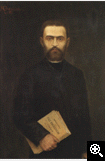|
|
|
| |
| |
Alberto Castigliano
| |
 |
|
was born in Asti on 8th November 1847. On December 1865, he completed a 3-year class at the Technical Institute of his town, moved to Turin where he enlisted at the fourth year of the Industrial and Professional Institute. In Turin he gets the certificate of Mechanician and Builder (23rd July 1866).
During the summer 1866 Castigliano attended a 3-month class at the Royal Industrial Museum of Turin, to become teacher of Technical Institutes. On 26th October he got the certificate of the Industrial Museum and on 8th December, when he was 19, he was appointed as professor of Applied Mechanics, Constructions and estimates at the Technical Institute in Terni. He had lived for 4 years in Terni, studying Maths in his leisure times. In November 1870, after returning to Turin, he passed (with top marks) the exam to be admitted to the faculty of Physical Sciences, Maths and Natural Sciences. Soon after Castigliano sent a letter to the University rector requiring to make, at the end of the first 3-year class, all exams of the 3-year class in Maths. His application, that was an event with no precedents, was accepted by the Ministry of Public Education (10th March 1871) and Castigliano, in 1871, obtaining top marks in all subjects but Drawing, got his certificate. Soon later he enlisted (10th November) to the Application School for Engineers of Turin.
On 30th September 1873 Castigliano became a civil engineer, on 19th November he was engaged by the Company of Railways Alta Italia (Sfai) and was sent to Alba with the qualification of department head entrusted with the maintenance. In Alba Castigliano remained up to 1874, when he moved to Turin.
On 1st February 1875 Castigliano was called by the Central Office of Arts in Milan, the technical head office of the company, by which the designing and the high technical surveillance of all main works of the railways lines in Northern Italy and mainly bridges, tunnels, buildings and roofs, depended.
Castigliano reached Milan as a student engineer, but only three years later, on 1st May 1878, he was appointed as a section head correspondant of the Academy of Sciences of Turin. In the autumn of 1884 he got ill and died of pneumonia.
|
| |
|
|

